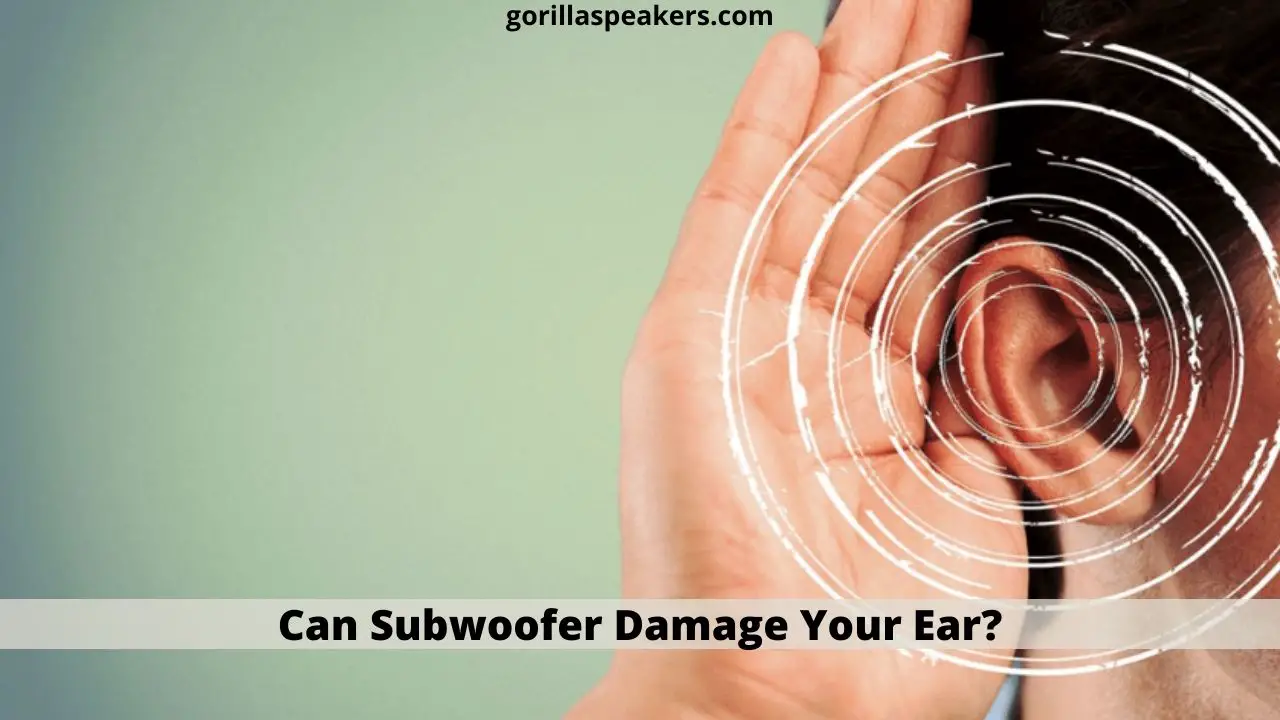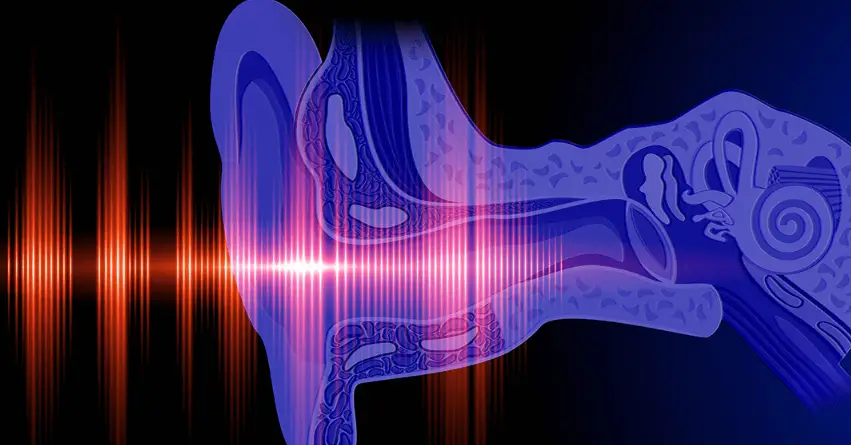If you are a music lover, a subwoofer will enhance your listening. But what if you experience ringing or tingling sensations in your head as a result of prolonged exposure to a subwoofer?
Listening to subwoofer continuously for an extended period of time can affect your hearing. Actually, exposure to loud music daily for long hours can do damage to your ears by destroying their structures.
So, have you ever considered the long-term consequences of being exposed to a subwoofer? Or, what can be listening to a Sub at an excessive volume do to your health? Here are some responses!
Can Subwoofers Damage Your Hearing?
Yes, a Subwoofer can cause damage to your ear and affect your hearing capability. Although the temptation of listening to music at maximum volume is understandable, doing so can result in permanent hearing loss. Like any other speaker, Subs can cause hearing damage if they are extremely loud.
Over the course of a day, your ear can withstand a maximum noise level of 75 decibels, but if your subwoofers are even louder, around 80-90 dB, they can cause ear injuries, and more Loud noise above 120 dB can cause immediate harm to your ears.
For example, being exposed to 120 dB for 5 minutes per day for seven days can cause ringing in your ears and head, eventually leading to deafness and hearing loss.
Loud noise can harm your cochlea’s cells and membranes ( part of the ear). Listening to loud sounds for a longer period of time can cause the hair cells in the ear to become overworked, causing them to die. The hearing loss worsens as long as the exposure to loud music is repeated.
Any sound that exceeds 90 decibels is considered harmful, so we should try to avoid such places on a daily basis. Aging is another factor that influences hearing. Our ears lose elasticity as we age, and as a result, upper frequencies are the first to go.
How Do Your Ears React To Heavy Bass?
Sound waves enter the outer ear consisting of the Pinna or auricle and move through a tight passage called the ear canal to the eardrum. The eardrum vibrates and conveys these vibrations to three small bones in the middle ear (malleus, incus, and stapes) in response to incoming sound energy.
The bones amplify the sound vibrations in the inner ear and send them to the cochlea (a snail-shaped structure filled with fluid).
The cochlea is divided into upper and lower quadrants by an elastic partition. This partition is known as the basilar membrane because it serves as the foundation for key hearing structures.
Once the fluid inside the cochlea is rippled by vibrations, there forms a wave along the basilar membrane. Hair cells are stimulated by the traveling wave.
When the hair cells move as a result of the stimulant, the microscopic hair-like projections (stereocilia) that cling on top of the hair cells bump into and bend against an overlying structure.
Bending opens up pore-like channels at the tips of the stereocilia. When this occurs, chemicals rush into the cells, causing an electrical signal to be produced.
The auditory nerve passing through carries this electrical signal to the brain, which turns it into a sound that we recognize and understand.
Bass And Low Frequencies Sensitivity!
Due to the wavelength of Low-frequency sounds, At the same level, a bass note has far more power than a high-frequency audio signal. So, low frequencies are equally damaging to our ears.
The outer hair cells, which are in charge of amplifying sound waves in the ear, show more sensitivity to low-frequency sounds than inner hair cells.
These outer hairs are thought to be responsible for otoacoustic emissions, which occur when sound is emitted by a small portion of the cochlea and is stimulated by soft beeping sounds.
When sound stimulates the cochlea, the outer cells vibrate. This vibration generates a nearly inaudible sound that echoes back into the middle ear. This suggests that the outer hair cells may be harmed when exposed to low-frequency sound waves.
The symptoms of exposure to Low frequency sounds on your health are discomfort, sensitivity to noise, and irritability. You may also face ringing in your ears, clicking or humming sounds caused by tinnitus, which is frequently a complication of noise-induced hearing loss.
How Loud Should A Subwoofer Be?
The hearing threshold of humans is around 0 decibels. Sounds with higher pressure levels are perceived as louder noises above this threshold. Sounds with a decibel level greater than 90 can cause chronic hearing damage if people are exposed to them every day.
85 decibels is considered the maximum volume at which you can listen to music for eight hours without harming your hearing. So, if you are used to listening to music through headphones for eight hours per day, listening to it at a volume louder than 85 decibels can cause permanent hearing damage.
There are alarming warnings in equipment manuals about hearing damage caused by excessive exposure to loud levels. You won’t have any problems if you don’t go crazy with it and don’t exceed your volumes.
Keep a watch on your sound levels and keep them moderate.
How Can We Protect Our Ears From Loud Bass?
There are many preventive measures to keep yourself safe from the damaging effects of subwoofers played on excessive volume. Some of these are mentioned below:
1- Playing Subs On A Low thumb:
Play your subs on a very low thumb, and if you are using a subwoofer during long driving, place it in the rear of the car, not in the cabin area. This would help a lot to keep safe from harming effects of subs.
2- Ear Protection:
Investing in-ear protection is the most cost-effective way to protect yourself from loud music while out in public or if you live near noisy areas such as airports and train stations. Go for earplugs that can block out all ambient noise.
3- Noise-Canceling Headphones:
Active noise-canceling headphones are not only fabulous for listening to music, but they are also very effective at blocking out low-frequency sounds.
That means that if a subwoofer with a frequency response of 20Hz to 200Hz is blasting music at a high volume around your area, you can simply put on your noise-canceling headphones and drown it out.
4- Maintain Distance From Loud Sounds:
Get some space and Distance yourself from loud music and noisy parties. This would aid in the relaxation of your auditory system.
Limiting your listening sessions and taking breaks are critical for your health. One thing you must do is put some distance between yourself and your subwoofer. As an example, if you sit close to the speakers or subwoofer, the sound pressure on your ears will increase, causing further damage.
5- 60:60:60 Rule:
The 60:60:60 rule states that you should listen to music for 60 minutes at 60% of maximum volume. After that, take a break of at least 60 minutes. This allows your auditory system to relax, making you feel more at ease.
6- Use Earbuds:
If you can’t go a day without listening to music, look for noise-canceling earbuds. That would aid in keeping your ears safe. When you drown out unnecessary noise from your surroundings, you won’t need to turn up the volume as much.
7- Tuning Subwoofer:
Tune your subwoofer by adequately adjusting your amplifier’s filters. It is critical to achieving good bass without causing too much damage. For the “by ear” method of tuning your system, see Tuning Your Subs.
Another method is to use test tones and a multimeter to match the amp’s gain to a specific output voltage. Many people notice changes in the tone of a new subwoofer after a few months of use. Because the breaking-in period affects the sub, tuning it after a few months will make your ears happy.
8- Use Subsonic Filter:
Because the human ear can only hear between 20 and 20,000 hertz, a subsonic filter is frequently used to protect your ears from loud noise. There’s no reason for your subwoofer to play frequencies lower than 20hz.
A subsonic filter keeps your subwoofer from hitting those frequencies, allowing it to perform more efficiently. This also prevents your sub from performing at such a low level. This allows your woofer to operate more efficiently, preventing overheating and promoting long-term survival.
Conclusion
Because subwoofers produce low-frequency sounds, your ears aren’t as sensitive to them as they are too high-frequency sounds. These will damage your ears if they are too loud.
As a result, just listen to normal levels, limit your listening sessions, and follow the strategies mentioned above, and you’ll be fine!


